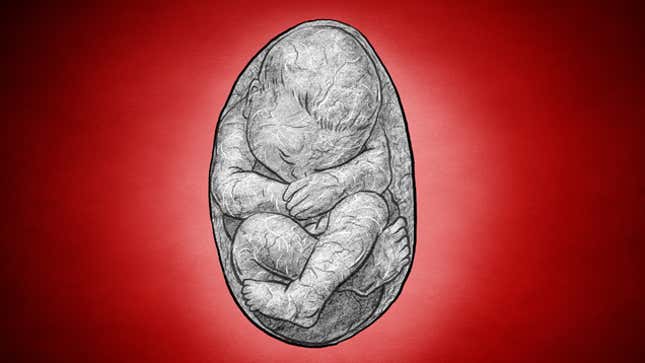A History of Lithopedions: When a Fetus Turns to Stone
Latest

In ancient Greek mythology, after the great flood, Deucalion and Pyrrha repopulated the world by scattering stones throughout the earth. From these stones emerged people; from these people grew the world. It’s a myth, but its opposite is possible. Sometimes, humans turn to stone.
A lithopedion baby, or stone baby, is formed when a fetus growing outside of the uterus dies. Too large to be reabsorbed back into its mother, the child calcifies to keep the mother safe from infection. Lithopedion babies seem to mostly occur in ectopic pregnancies: only 13 of the reported cases of lithopedions were uterine, and the resulting stone children were found in the abdomen after the uterus ruptured during birth. Many women who have lithopedions go on to have other children, carrying their flesh-and-blood children in the same body that’s housing their child of stone.
There are only around 300 documented cases of lithopedions in the world. The earliest case in modern record is known as the lithopedion of Sens: a little girl, born in 1582, from the corpse of her mother, Madame Colombe Charti. Charti was the wife of a tailor, and she died at 68 after complaining for 28 years of abdominal pain and a loss of appetite, which she could trace back to the pregnancy she had at age 40. It was a mysterious incident: her period stopped, her breast and stomach grew; she even felt the child inside of her move. But when she went into labor, nothing emerged except amniotic fluid tinged with blood. Madame Charti suspected that the child remained inside, but no doctor could help her.
After her death, her husband ordered an autopsy. The skilled surgeons, Claude le Noir and Iehan Couttas, cut into Madame Charti’s body and saw a large growth in her stomach. They broke their razors trying to penetrate the tumor, so they attacked it with mauls and drills. Finally they cracked open the stone and saw inside the head and shoulder of a child.
Excited by their discovery, the surgeons called in other physicians and continued to tear away at the calcified remains with iron tongs. In his book The Two-Headed Boy, Jan Bondeson describes the tumor as hard, “wrinkled and formed like a turkey’s crest.” The child within it looked like this: “The right arm extended down toward the navel; its hand had been broken off through carelessness when the stone-child was extracted. The bones of the head were transparent and the fontanelles were not closed. In several places the skin of the head was covered with hair. The stone-child had one sole tooth, situated in the lower jaw.”
Jean d’Ailleboust, one of the attending physicians, acquired the baby and wrote a pamphlet about the mysterious stone child; it became a bestseller. In the pamphlet he drew a picture of Charti, cut open and lying dead on a bed, a stone child inside of her and beside her. Bondeson speculates that the image, which looks nothing like a 68-year-old woman, was inspired by pornography. The image shows a woman, head back as if in a pose of ecstasy, or agony. That this moment would be sexualized is immediately off-putting: Madame Charti isn’t even given the dignity of her own body being commemorated, the body that produced this stone fruit of the womb.
-

-

-

-

-

-

-

-

-

-

-

-

-

-

-

-

-

-

-

-

-

-

-

-

-

-

-

-

-

-

-

-

-

-

-

-

-

-

-

-







































